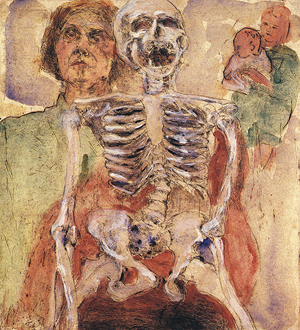

'The Four Stages of Human Life'
(plate 5, page 16)
©May H. Lesser
I am reminded of a James Ensor print entitled Myself in the Year 1960. He made it in 1860, and his image of himself was a skeleton! This etching -- my first -- was done about twenty-five years ago. I began with a dried-out skeleton. I remember that while in sizing the plate, I saw my face reflected in the mirror of the polished metal. Tilted upward, my features seemed askew and somehow frightening. Afterward I added the image of a mother and child. And many years later, I added a title, The Four Stages of Human Life, referring to the four stages of my own life: child and mother, mother and child, myself, and the skeleton I would become.
The mother and child remind me of a squatter family I drew forty years ago. They and three other families -- the homeless of that era -- were living on a Mississippi levee in World War II army tents. The etching was part of my senior thesis at college, a pictorial documentation of their lives accompanied by some text, consisting of what they told me about themselves as I drew them.
So this project has its precursor. Once again I'm living with a group of people, recording what they say to me, drawing them at work. Only this time, the group is far more privileged. Yet they are like a family too, united by a common commitment. And like a family, the doctors, staff, researchers, and support groups are of all ages -- from very young to very old.
Years ago I understood that I worked best when I became so completely identified with what or whom I was drawing that I forgot myself. Then I could discern the harmony of parts, the design of the whole. That is what I am trying to do today.
Last Reviewed: May 11, 2012

